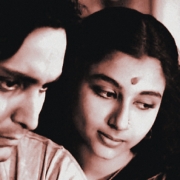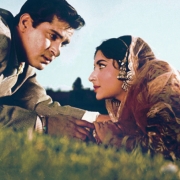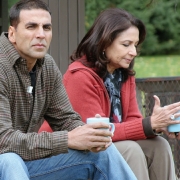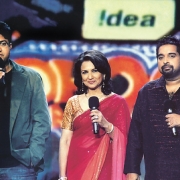
People
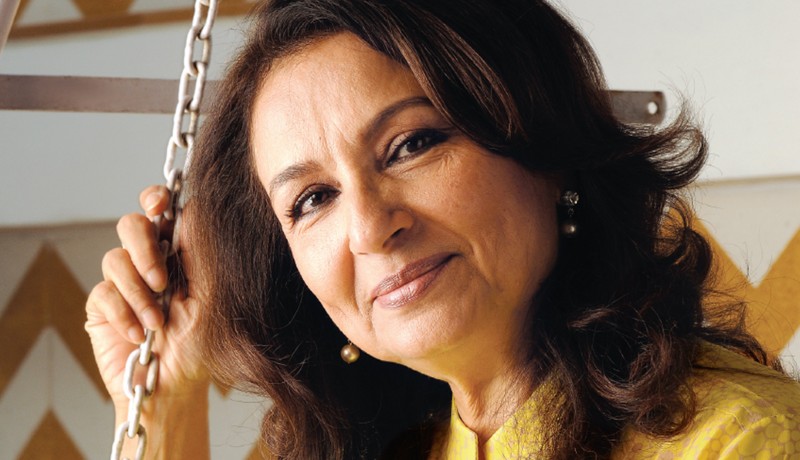
A master at the art of adaptation, Sharmila Tagore plays the many roles in her life — actor, aristocrat, parent, censor, cognoscente, goodwill ambassador with effortless élan. Her memories are vivid, her convictions strong, and her words eloquent, as Arati Rajan Menon discovers on a balmy afternoon in New Delhi
This is what it must feel like to be so incredibly comfortable in your own skin. Sharmila Tagore at 62 in flip-flops, cropped pants and a paisley shirt, hair casually pulled back, not a trace of makeup on her glowing face. Looking out over a sun-dappled courtyard, her living room in South Delhi’s fashionable Vasant Vihar echoes her effortless confidence with a muted elegance that reveals no telltale clues about its inhabitants. Beige walls and white sofas; miniatures punctuated by works by Jamini Roy, Paresh Maity and Sachin Jaltare; silver and crystal bric-a-brac on the teak and marble-topped tables; the odd Diptyque candle. Amid this serenity sits Tagore, actor, aristocrat, a master at the art of adaptation.
An award-winning performer who began working at the age of 14 and never really stopped, she wrapped up three films in 2008 alone: Marathi film Samantar directed by and co-starring Amol Palekar; Antaheen directed by Aniruddha Raychowdhury, a casting coup that brings her together with Aparna Sen; and Nagesh Kukunoor’s 8 x 10 Tasveer, a thriller that released in April where she plays Akshay Kumar’s mother. Further, she squeezed in time to play judge on reality music show Dhoom Macha De along with composer-singer Shankar Mahadevan and lyricist Prasoon Joshi — an experience she loved because “I could be myself”. Tagore is also chairperson of the Central Board of Film Certification, a post she has held since 2005, and a goodwill ambassador for UNICEF — she works with HIV/AIDS patients.
A person who is constantly “in evolution”; Tagore craves music, books, conversations, experiences, for they help her grow. “There’s no real point when you know it all, is there?” she asks, eyes sparkling. What she does know, however, she believes in fervently. And communicates eloquently.
IN HER WORDS:
People keep clamouring for ‘different films’ but would rather support a Singh is King than a Little Zizou or Firaq. Our industry and films are still male-dominated and people want very superficial entertainment. Even in a multiplex film, they would choose something like Dev D with more shock value. A film directed by a woman that has less violence and more nuance doesn’t get the same kind of support. The standard of critics in our country is also very poor. It’s like Oscar Wilde once said, “The play was a success but the audience was a damn failure!”
After I saw Dor and Iqbal, I told Nagesh Kukunoor I’d like to work with him. Then he offered me 8 x 10 Tasveer. It’s a different genre, a thriller, but I enjoyed it. I also completed Samantar with Amol Palekar last year — he’d been wanting us to work together for a long time. It was a challenge because I had to speak in Marathi. It’s a very cultured language, like Bengali, and you need to get the diction right. The connection between the audience and the actor breaks instantly if you hit the wrong note.
As an actor, I would describe myself as competent. There’s no end to being better. I played the ‘heroine’ consistently till 1980, after which I started doing character roles. But even while I was doing glamorous films like An Evening in Paris, I would also do more serious roles like Anupama. Mausam had some challenging elements in terms of doing a double role and playing a sex worker. I also enjoyed Safar because I played the role of an independent, professional woman [doctor]. Otherwise your reference point is always a man. Though I feel there’s more strength and naturalness towards the end of my career, the innocence in the early films also has its charm.
How can you go from Satyajit Ray to Shammi Kapoor? That’s what many Bengalis wondered when I moved to Bombay in 1963 to act in Kashmir ki Kali. They felt let down. But I was a floater — I just decided to explore a new avenue. Bombay was a culture shock. I struggled to lip-synch for my songs, grappled with dance steps, and tried awfully hard to look glamorous and sexy. Still, I never felt I was betraying my roots because I was secure in my own identity and had the support of my parents. I had abundant resources inside me to draw from.
My Bengali core has always been very strong. I am related from both sides of my family to Rabindranath Tagore. We lived in a joint family: my grandfather, his brother and their families. At any given time there were about 15 children in the house. We celebrated every festival along with the attendant rituals and cuisine; even the alpana would differ accordingly. We mingled with the adults a lot; we participated in their discussions, recited our poetry to them, and sang — I was the worst singer and hugely teased for it!
As a Bengali — or any actor for that matter — you can’t get a better debut than to work with Satyajit Ray. I was only 14 when he directed me in Apur Sansar. For my first ever shot, I had to cross over the threshold and enter a room. I never asked Manik da [Ray] if he actually intended it to be so symbolic! A year later, I did Devi with him. I was completely uninhibited in front of the camera because I was so young. Besides, I had no problems understanding the nuances of my characters. We were very different from teenagers today. We wore saris and carried ourselves with elegance. We were well read and precocious — I remember I would sit in front of the mirror and dream endlessly.
I was a suspect when I first came to Bombay. The norm for heroines in the industry was to wear white saris, be constantly chaperoned and never drink or smoke in public. But I lived on my own in hotels; did what I liked; wore hipsters. The film world reacted very strongly. Over time, I learnt that you can save yourself a lot of trouble by conforming and cultivating a certain public image. You have to choose your battles — every battle is not worth fighting for.
It was as tough to conduct a romance in the public glare in the 1960s as it is today. I met Tiger [Mansur Ali Khan, the Nawab of Pataudi] in 1965; we were engaged in 1967 and married in 1968. Though the media was not quite so intrusive, there were plenty of rags who would write distasteful things. People also made much of the religious and cultural differences but there was really no dramatic transition. Tiger and I both came from old families who were equally feudal. We knew the arts of sharing, tolerance and diplomacy, so necessary in an extended family. The only adjustment was that in Tiger’s household, they had to make rice — which they call khushka — especially for me. And I had to make my own fish curry!
As you get older the price tag on your mistakes gets steeper. That’s something I try and tell my children. My instinct tells me when to keep quiet and when to assert myself with them. Although we can’t impose our views on them, they are as confused as any generation and can benefit from our experience, learn from our mistakes. You don’t have to touch fire to know it burns! But I guess they have to make their own mistakes too — experience pain, loss, humiliation even — and learn from them.
Having Sharmila Tagore as a mother has been an advantage and a drawback for Saif and Soha. They walked right into the industry. Imagine coming from a small town. How do you start? There are so many heartbreaks. But the problem for our children is that once they arrive, they have to live up to people’s expectations. And that’s very hard. As for Saba, she always wanted to become a [jewellery] designer so she went to art school. Tiger has also nominated her as mutawalli [chief trustee] of our estates and shrines in Bhopal — she’s quite a religious girl and the most appropriate choice.
I was the first mother-in-law to be in the labour room of Breach Candy Hospital in Bombay! I was terrified to hold my granddaughter Sara when she was born; she was so tiny. Saif handled her like a pro though. Now, she’s 13 and her brother Ibrahim is 8. Sadly, because of the distance — they live in Mumbai — and the divorce, we don’t get to see them too often. With the children already dividing their time between their parents, it seems unfair to put more demands on them.
Tiger and I share our silences very well. After 40 years of marriage, words and gestures are not always necessary. Both of us enjoy our own company so we give each other plenty of space. We also enjoy our holidays together to England, or Pataudi, which is very healing because you are so cut off from everything. The greatest life-lesson from marriage is that you can’t ‘fix’ or change each other — there are certain things you’ve agreed upon, and what you’ve never agreed upon you never will. Know that and you’re happy.
Shooting in America for Mira Nair’s Mississippi Masala was an empowering, and enlightening, experience. The system was so efficient; as an actor the union would look after you. I got a check for $ 800 after I returned to India with a polite note that it was for rehearsals and overtime! We all lived in a motel in Greenwood, Mississippi, and cooked in our rooms. With the ‘per diem’ I received, I bought myself a fridge, an ironing board and iron. The entire unit would get together in the evenings. It was so much fun. I also saw the flipside of the American dream in Mississippi; the racial prejudice, poverty, illiteracy, the proliferation of encephalitis. They just sugar-coat their inequalities better.
No filmmaker can work out of context from his environment. Cinema’s job is to uplift you and transcend reality. But if it can deliver a political comment without compromising on its aesthetic sensibility, like Picasso’s Guernica [about the bombing of Guernica in Spain by Germany during the Spanish Civil War], that’s even better. If your film can even touch one soul, it’s a great thing. Our society has many closed doors that films and actors can try and open.
Unfortunately, the industry has become an inward-looking club where people talk about their own films and play their own music at their own parties. Things used to be different. I remember Ashok Kumar with his repertoire of jokes. Other stimulating conversationalists were Balraj Sahni and Motilal. Or Gulzar and Yusuf saab [Dilip Kumar] — the Punjabi they speak is almost lyrical. That era ended with actors like him and directors like Hrishikesh Mukherjee and Bimal Roy. The industry became self-obsessed. There’s also no understanding among younger actors of what has gone before them, no knowledge of the legacy of cinema. It’s like Sehwag once asked, “Who’s Vinoo Mankad?” You see the same attitude in the film industry.
Even Aishwarya Rai would be considered old by today’s standards. And what of Madhuri Dixit? It’s so sad. That’s why you have a ‘life stops at 30’ syndrome where you take home whatever you can and then get married. I was fortunate enough to keep working — Aradhana was released after my marriage; Amar Prem after Saif, Mausam after Saba, Grihapravesh after Soha. But as you get older, you don’t get powerful roles. Those go to men like Om Puri or Anupam Kher. They are undoubtedly brilliant actors — but so is Waheeda Rehman. Still, the girls in films today are on a better wicket. In my time, the women were really exploited. Almost everyone had a male ‘mentor’ who would never marry you but had you at their beck and call. Today, you are your own person and not somebody’s pleasure object.
If you are 60, all the Botox in the world won’t get you Deepika Padukone’s roles, or even Juhi Chawla’s. In fact, looking your age might get you even more interesting roles. Just look at Zohra Sehgal! It’s important to look good as long as you don’t make a caricature of yourself. Groom yourself well, colour your hair — whatever makes you feel good — but accept that ageing is inevitable. Instead of being stuck in a time warp, you can be more attractive and interesting to younger people by expanding your own horizons.
There’s something very exotic about watching a film where you don’t know the language. I watch a lot of foreign films when I am in England — European, Chinese, Iranian. In music, I listen to everything from qawwali to jazz, Rabindra Sangeet to film songs. I loved Rahman’s Jodha Akbar soundtrack and one song from Delhi 6 — no, no, not Masakalli, the other slow one! Whenever I hear a song I like, I put it on my iPod.
I am addicted to exercise. Unless I’m travelling, I go to the gym everyday — an hour of cardio followed by stretches. I have no serious health problems, just some aches and pains, so I eat everything, albeit with less oil. I eat vegetarian during the day and non-vegetarian at dinner. When I put on weight, I give up my evening phulka for a while.
I’m now planning to nest for a while. Last year was extremely busy with my films, the reality show and my work with UNICEF. Now I am in spring-cleaning mode. It’s been over 20 years since I sorted out our homes [in Delhi, Bhopal and Pataudi]. I need to sort out the children’s things — they refuse to take their stuff! I’m also working on a garden in Pataudi on a plot of arid land. To create something out of nothingness, now that’s a challenge — it consumes my thoughts these days.
Archival Photos: Indian Express Featured in Harmony – Celebrate Age Magazine May 2009
you may also like to read
-
For the love of Sanskrit
During her 60s, if you had told Sushila A that she would be securing a doctorate in Sanskrit in the….
-
Style sensation
Meet Instagram star Moon Lin Cocking a snook at ageism, this nonagenarian Taiwanese woman is slaying street fashion like….
-
Beauty and her beast
Meet Instagram star Linda Rodin Most beauty and style influencers on Instagram hope to launch their beauty line someday…..
-
Cooking up a storm!
Meet Instagram star Shanthi Ramachandran In today’s web-fuelled world, you can now get recipes for your favourite dishes at….



